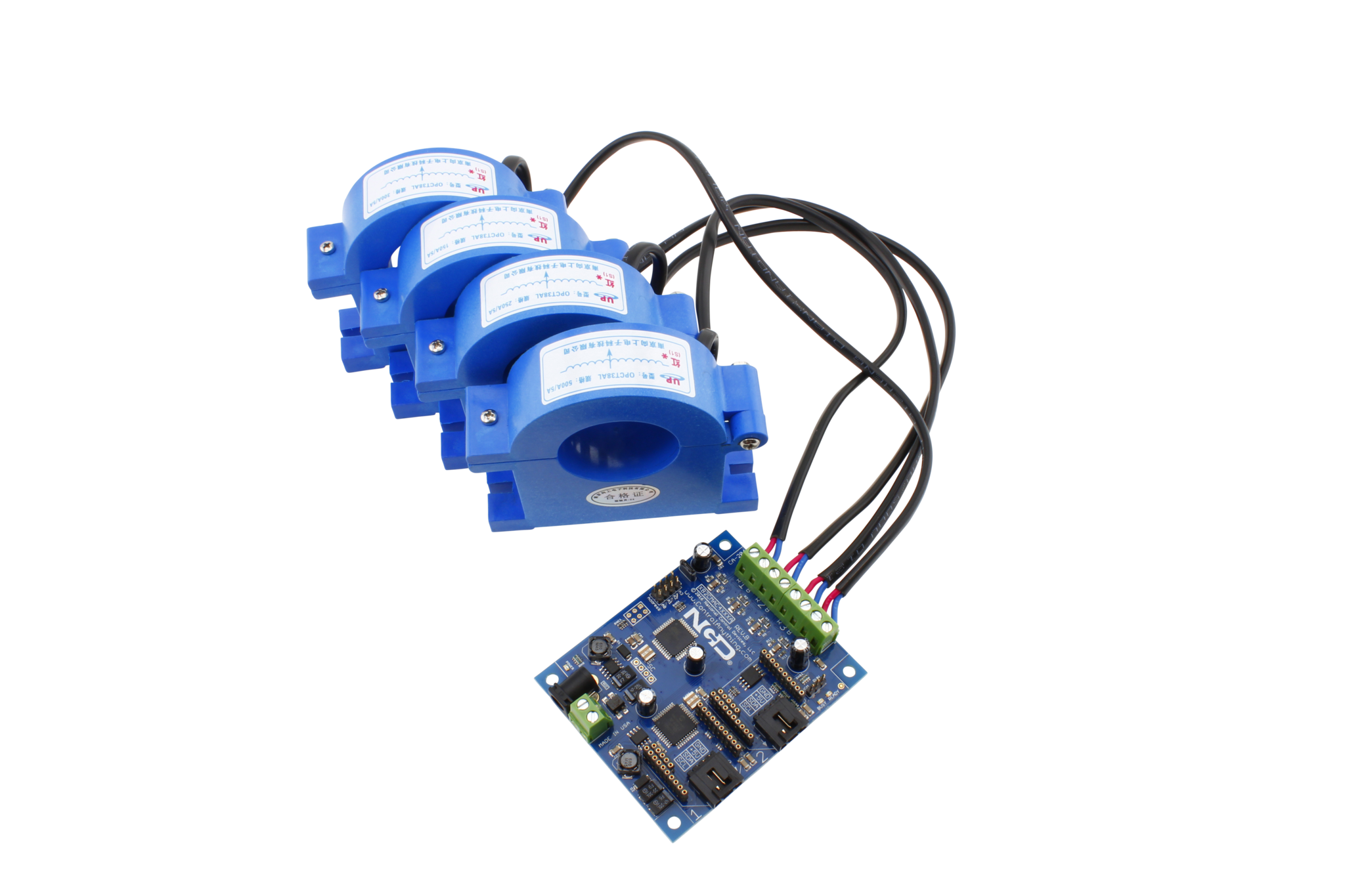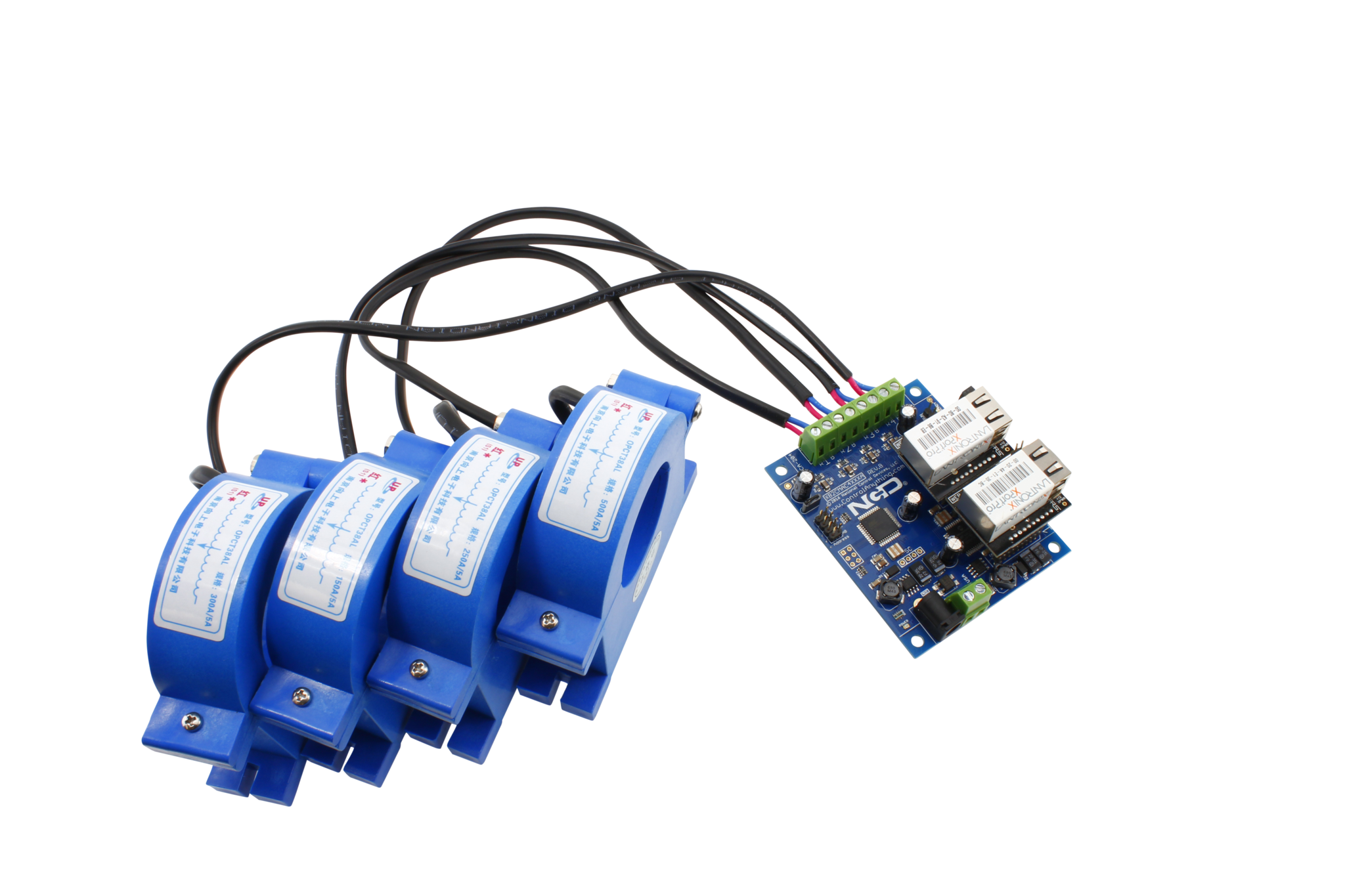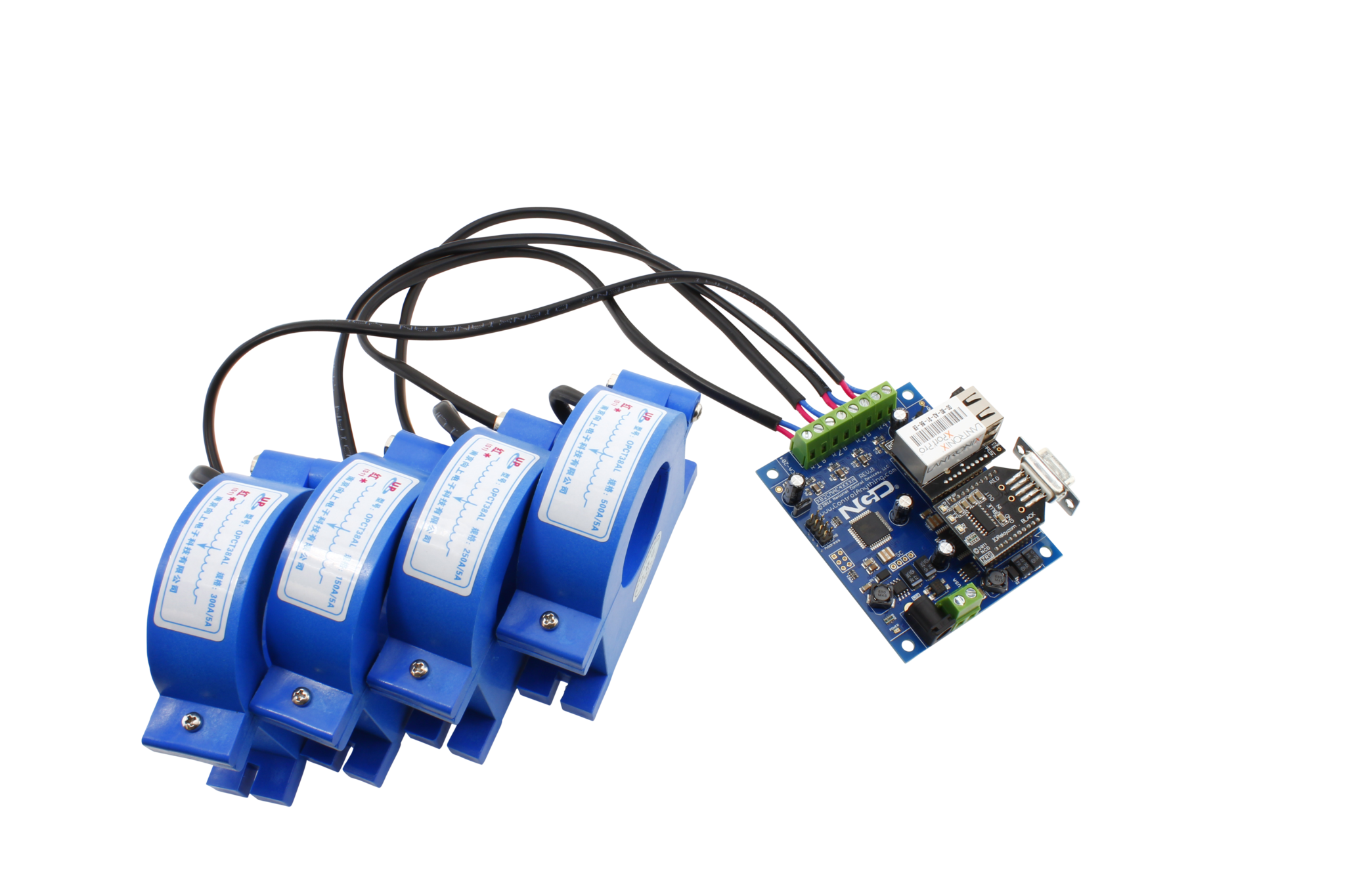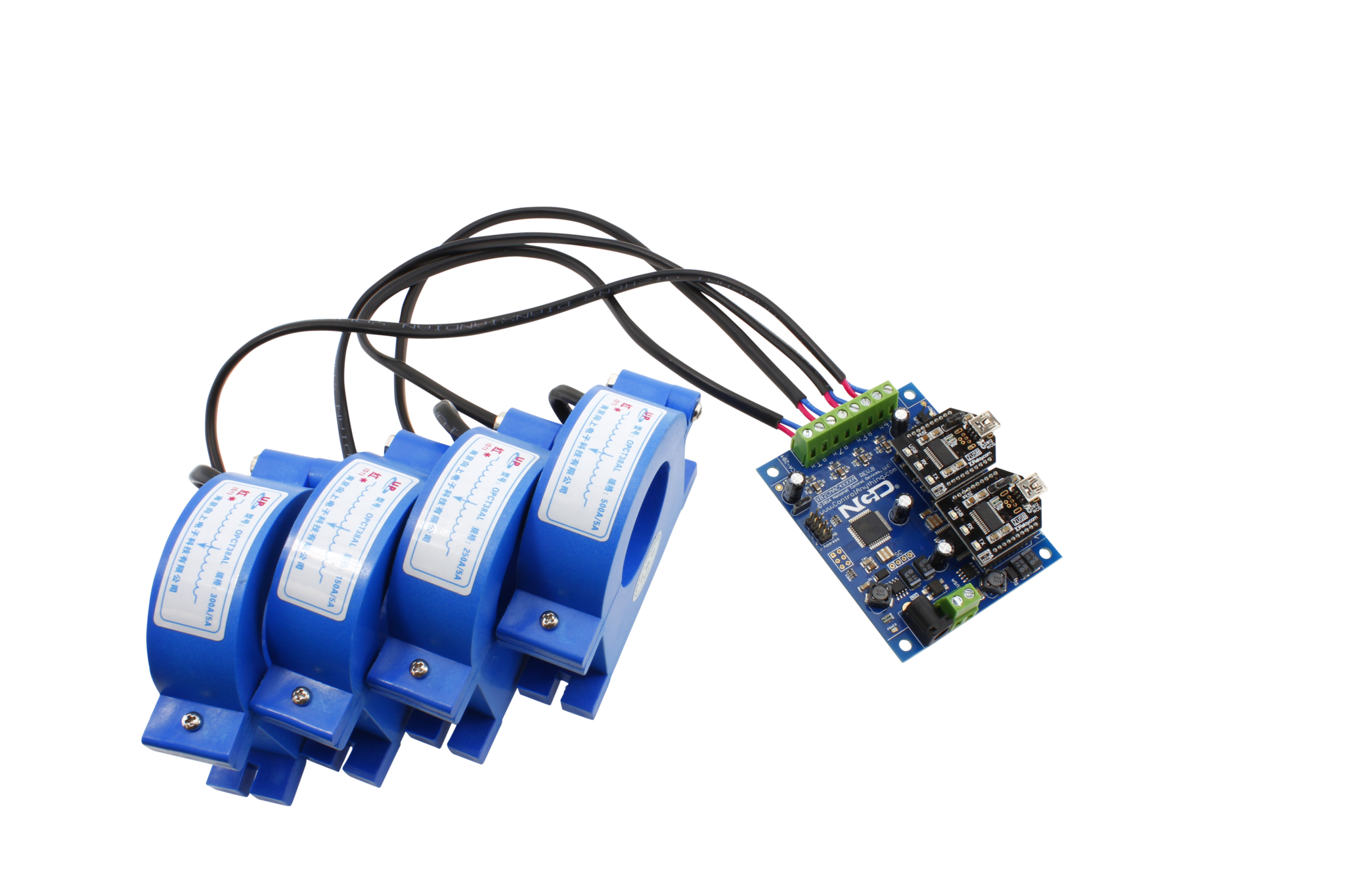Industrial High-Current Monitor 4-Channel 100-600 Max Amps Wired Split Core Dual Interface
Highlights
- Current Monitoring with Dual XBee® Interface
- Compatible with Select Digi XBee® Wireless Modules
- Ethernet, Bluetooth, Wi-Fi, USB, and RS-232 Interface Options
- 6 Energy Monitoring Input Channels
- Options for up to 600 Amp Monitoring per Channel
- Split-Core Off-Board Current Sensors
- 2% Max Error Rate for Resistive Loads
- May Be Calibrated for Inductive loads or Higher Accuracy
- 1.5 Meter Cable between Sensors and Controller
- Dual On-Board I2C Expansion Ports for Unlimited Expansion
NCD Current Monitoring Devices
Current monitoring has never been easier, or more accurate using XB2x series current monitoring controllers. The XB2x series includes off-board current sensing, designed to safely clamp over a single high-current wire for current consumption measurement applications. When properly calibrated, up to 6 high-current loads can be monitored simultaneously with a maximum error rate of 2%.
All XB2x series controllers include two communication ports compatible with our entire range of communication options, including Ethernet, Wi-Fi, Bluetooth, USB, or RS-232. For long-range, high-speed wireless communications, use the second communication port for industrial wireless applications supporting the Digi 802.15.4 and Digi S3B DigiMesh® communications modules. This device provides an ideal energy monitoring solution for most industrial and commercial applications at a low cost with unmatched accuracy.
Energy Monitoring Choices
Because we custom-build every controller, you have plenty of options. Simply choose the type of computer interface, the number of channels, type of sensor (split-core or solid-core), and your maximum current load (in amps). We will ship your controller pre-tested and pre-calibrated to 98% accuracy.
Tuning Ranges
When it comes to measuring a wide range of currents, there are many choices. In order to get the most accurate readings, you need to select exactly what you need and nothing more. Don’t be alarmed to see a 100 amp sensor on our web site offered with a 10 Amp measurement range. We do this for the sole purpose of improving accuracy. The electronics and the firmware were tuned to operate in the 10-amp range.
If you need to monitor a 10 amp circuit, you should choose a 10 amp controller (not a 20 amp controller). While there is no difference in cost, there is a significant difference in resolution. A 10-bit sensor reading across a 20-amp range will have HALF the resolution per bit as a 10 amp sensor. For this reason, and for the best possible resolution per bit, we offer many tuning ranges.
Solid Core Sensors
You may have noticed we offer both split-core and solid-core sensor options. Solid-core sensors are ideal in applications where low-cost or tight spaces are required. Solid-core sensors are not able to clamp over existing wire; they require a wire to run through the sensor during installation of the wiring. Solid-core sensors are a great choice for new installations. Because the sensor does not “break apart” like a split-core sensor, it has a smaller size and a lower cost.
Split-Core Sensors
For installations that must be retrofitted to add current monitoring, split-core sensors are our most popular choice. Split-core sensors can clamp over existing wiring by breaking apart the sensor and snapping it in place over the wire. Split-core sensors are larger and more expensive, but the versatility and ease of connection make them extremely popular.
Connection Options
Connecting sensors to a controller usually involves connecting two wires to the screw terminals of a controller. However, our SCT013 sensor includes a plug and a jack, reducing installation time.
Inductive and Resistive Loads
Unlike competing products, we do not gloss over the difficulties in monitoring highly inductive loads, such as motors, pumps, and other electrically noisy devices. We spent months developing algorithms that provide an excellent balance of speed and accuracy, whether you are monitoring resistive loads or inductive loads. Because of the difficulties in measuring inductive loads, our (free) Base Station software can be used to help fine-tune the calibration values to provide a more accurate measurement, further reducing the error rate to less than 2% for the most demanding loads.
Software
To get started quickly, use our free Base Station software. Base Station will have you monitoring energy in minutes, offering direct compatibility with your favorite communication technology (excluding Digi Wireless technologies). We highly recommend at least one USB interface in case you run into problems. Base Station and a USB interface can help get you connected fast!
Expandability
NCD Energy Monitoring controllers are designed with expandability in mind. Each controller includes two on-board I2C expansion ports, making it easy to expand to our complete line of I2C sensors, FET controllers, PWM controllers, and I2C relay boards.
Details
NCD Energy Monitoring controllers are rated for use with AC ONLY and will not work with DC loads. We have not yet completed 3-phase testing, but preliminary results are very hopeful. NCD Energy Monitoring controllers require 1.5 seconds to evaluate each channel. Therefore, a 6-channel controller will require 8 seconds to return a result for all channels. Sensors and controllers are designed to work together; it is NOT POSSIBLE to mix sensors to monitor different load sizes with a single controller. Mismatching sensors and controllers can result in permanent damage to the controller.
Users should avoid extending the cable of the current sensor as much as possible. Extending the wires may decrease accuracy.
Our tuning electronics can accept up to 5% current above the rated range, exceeding 10 amps + 5% for an extended period of time may cause damage to the tuning electronics or the CPU on our controller.
Off-board current sensors have a minimum load requirement of 1% of the total rating of the sensor. Failure to meet the minimum load requirements will significantly reduce accuracy. Please see minimum load requirements below.
Sensor |
Rating |
Type |
Connection |
Tuned Range (Amps) |
Minimum Load |
|---|---|---|---|---|---|
| DLCT27CL20 | 24 | Solid Core | Two-Wire | 5, 10, 15, 20 | 240mA |
| OPCTL16AL | 100 | Split Core | Two-Wire | 10, 20, 30, 50, 70, 100 | 1 Amp |
| SCT013 | 100 | Split Core | 3.5mm Jack | 10, 20, 30, 50, 70, 100 | 1 Amp |
| OPCTL38AL | 100 | Split Core | Two-Wire | 100 | 1 Amp |
| 150 | 150 | 1.5 Amps | |||
| 200 | 200 | 2 Amps | |||
| 250 | 250 | 2.5 Amps | |||
| 300 | 300 | 3 Amps | |||
| 400 | 400 | 4 Amps | |||
| 500 | 500 | 5 Amps | |||
| 600 | 600 | 6 Amps |
Choose Any Two Communication Modules
NCD current monitoring controllers support many communication options. With a dual interface, choose any two of your favorite communication technologies. Choose from USB, RS-232, Ethernet, WiFi, Industrial Wireless, or more.
XBee® is a registered trademark of Digi International. www.digi.com
Wiring Diagrams
Essential
Communications
- NCD Gen3 Ethernet Module User Guide
- NexGen WiFi Module User Guide
- RS-485 to Wireless Converter Modem Guide
- RS-485 Network Quick Start Guide
- KFX Key Fob Communications Module Quick Start Guide
- (Deprecated Technology) WiNet Gateway Quick Start Guide
- Digi 802.15.4 Quick Start Guide
- (Deprecated Technology) Lantronix XPort Communications Module Quick Start Guide
- E3C DropNet Quick Start Guide
- (Deprecated Technology) Web-I WebRelay Communications Module Quick Start Guide
- (Deprecated – Legacy Hardware) WiFi Communications Module Quick Start Guide
- ZRS RS-232 Communications Module Quick Start Guide
- ZUSB USB Communications Module Quick Start Guide
- (Deprecated – Legacy Hardware) ZBT Bluetooth Communications Module Quick Start Guide
Tutorials
- Unable to Mount Virtual COM Port in Windows 10
- Current Monitoring Controllers Command Reference Guide
- Linux Relay Controller using Netcat for Ethernet and WiFi
- Using Comm Operator to Control USB Relays
- Choosing the Right USB Relay Controller
- Using Comm Operator to Control Ethernet Relays
Download NCD Base Station
WiFi Module Setup
The Wi-Fi Communications Module must be configured in order to connect to your network using the Wi-Fi Configuration Kit. The Wi-Fi Configuration Kit consists of a small black board with 3 LEDs. The Configuration Board will be labeled ZIGMO. The module may have to be removed from the board and plugged into the ZIGMO as shown. The ZIGMO will plug into the USB port of your computer for configuration and some USB drivers may need to be installed on your computer. Base Station software is required to configure the Wi-Fi communications module and is available as a free download. This software identifies compatible Wi-Fi routers in your area and assigns the router you have chosen to the Wi-Fi communications module. Network security options may be configured using this software including passwords. You can find the NCD Base Station Software at ncd.io/start.
Introduction to Ethernet Relay Control
This video will introduce you to Controlling Relays over your Local Area Network (LAN) using Ethernet Relay Controllers from store.ncd.io. Ethernet can be one of the more complicated communication interfaces due to the network protocol stack. We break it down for you to show you the most important parts for Relay Control. You can find NCD Base Station at ncd.io/start.
USB Intro
We explain the advantages and disadvantages to USB communications and how it effects our Relay Controllers and your application. Some of the information is outdated as we’ve moved away from controlanything.com. Most modern operating systems come with the FTDI driver installed so you should just need Base Station
USB FTDI Communication Module Compatible with the Digi XBee ® Controlling Relay
FT232RL USB Interface Adapter Similar to the Digi XBee ® footprint shown controlling a 16-Channel Relay Controller Board Available from https://store.ncd.io/product/usb-communications-module-ft232rl-zusb/ Drivers Available from FTDI: http://www.ftdichip.com/FTDrivers.htm Base Station Software: ncd.io/start Digi.com offers a wide variety of XBee Interface modules for industrial wireless applications. Digi XBee® devices are compatible with NCD products.
USB Setup
Learn how to set up you own ZUSB Module to work with your NCD Relay Controller. For complete instructions and details on how to use an NCD ZUSB Module see our article at https://ncd.io/zusb-usb-communications-module-quick-start-guide/ Portions of this video may be outdated as we have moved from controlanything.com since this video was created.
802154 RANGE
A simple demonstration of the Wireless Range of 802.15.4 in the 300′ and 1 Mile Range with and without obstacles.
Wireless Range Testing Setup
This video tells you the set up that we used to get real world ranges on our wireless communication modules.
WiFi Introduction
Introduction to our WiFi Module and technologies. Learn the advantages, disadvantages as well as tips and tricks for using WiFi Relay Controllers available from store.ncd.io. You can find more in depth information on how to use and configure your WiFi Relay Controller at https://ncd.io/wifi-module-quick-start-guide/.
Ethernet over Virtual Serial Setup
Learn how to communicate to your Ethernet Module using a Virtual COM Port. Virtual COM Port communications are ideal for existing applications that make use of our wired and wireless relay control already and want to quickly add support for Ethernet Relay Controllers. Virtual COM Port communication allow you to send commands to an Ethernet Relay Board as if it were directly connected to the controlling PC.
Finding the Com Port
Learn how to find the COM Port on your windows based computer. You can also use Base Station to find the COM Port of your Relay Controller. Base Station can be downloaded at ncd.io/start.
Wired Communications
Get the rundown on the pros and cons of all the Wired Communication Interfaces we offer. If you want to know which wired technology will best suit your needs this video will get you the information you need in just a few minutes. Whether you need the power of ethernet or the simplicity of RS-232 we have something to fit your application.
900HP-S3B Wireless Compatibility Notes
Notice: Compatibility Notes Does NOT Apply to the Following Products:
- NCD Enterprise Solutions
- NCD Wireless Sensors
- NCD Enterprise Modems and Gateways
Notice: Compatibility Notes Applies to NCD Industrial Products, Including Fusion, ProXR, ProXR Lite, Taralist, and Reactor Series Products.
Compatibility Notes
When using an 900HP-S3B communication module, it is essential that you use the ZIGMO_PCB to configure the module settings. Long-Range wireless sensors may be programmed over the air without removing the communications module.
A 900HP-S3B Modem or a gateway of some kind that support the 900HP-S3B communications module will also be required.
Ethernet TCP/IP Compatibility Notes
This device periodically sends UDP Packets on port 13,000, which help identify the IP address of this device on your network.
RS-232 Serial Compatibility Notes
The NCD RS-232 Serial communications module is compatible with standard RS-232 signals (+/-10VDC), which are not directly compatible with UART signals from a microprocessor. If you are working with Arduino, Microchip PIC, or other common microcontroller, a communications module is not required. Microcontrollers will directly talk to the on-board processor of all NCD controllers.





